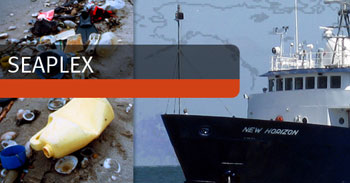From Scripps News:
SEAPLEX: Scripps Cruise Returns
“Scripps Institution of Oceanography SEAPLEX scientists who recently returned from a 20-day expedition to the “Great Pacific Ocean Garbage Patch” will recount their research expedition and be available for one-on-one interviews. SEAPLEX is the Scripps Environmental Accumulation of Plastic Expedition.
(snip)
The North Pacific Ocean Gyre is roughly a thousand miles off California’s coast. Just what effects the accumulation of human-produced plastic and other debris has on this ocean area is a subject of current speculation. Scientifically, very little is known about the size of the “garbage patch” and threats to marine life and the gyre’s biological environment. From August 2-21, Scripps Institution of Oceanography at UC San Diego, with support from UC Ship Funds, Project Kaisei and the National Science Foundation, dedicated a scientific mission to exploring and analyzing the problem of plastic in the North Pacific Ocean Gyre. The graduate student-led SEAPLEX expedition aboard the Scripps research vessel New Horizon explored the ocean patch from several angles, with research that included surveys of plastic distribution, investigations of floating plastic and assessments of impacts on sea life.”
—
The Great Pacific Ocean Garbage Patch certainly is getting more attention. Last year it seemed like I couldn’t find much info on it. This time around I found a lot more.
The main Seaplix (Scripps Environmental Accumulation of Plastic Expedition) site has a lot to check out. You can read that here.
The crew on the Scripps Cruise started a blog-SEAPLEX Seeking the Science of the Garbage Patch. They even have a Flicker page here.
I find all this fascinating and troubling. Maybe in a few hundred years a fish will evolve and be able to digest plastic?
Posted by Vixen as News at 11:58 PM CDT












